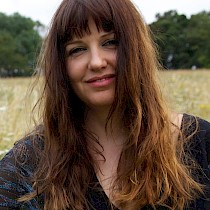Dr. Lily Hibberd

Future memories: immersive media and collaborative artistic reconstruction of the past
Lily Hibberd is an interdisciplinary artist, curator and writer working on frontiers of time and memory. She is ARC DECRA Research Fellow at National Institute for Experimental Arts at UNSW Art & Design, a fellowship supporting collaborative new media research with Parragirls. She holds a PhD in Fine Art from Monash University. She is founding editor of the bi-annual art writing publication un Magazine and is known equally for her practice as both an artist and critical writer.
Lily co-founded Parragirls Memory Project with Bonney Djuric in 2012. As memory project Creative Director (2012-18) she has co-authored numerous major artworks, exhibitions, articles and small publications with Parragirls and other project collaborators. In 2016-17, she co-created Parragirls Past, Present with Parragirls and media artists Volker Kuchelmeister and Alex Davies.
Lily has exhibited in major institutions and festivals across Australia and Europe. Other recent projects include Data Horizons for Edinburgh Science Festival (2017, multimedia installation); The Public Secret (2017, immersive video installation); The Phone Booth Project with Curtis Taylor (2012-2017, immersive video installation); First Light for the UNESCO International Year of Light at Musée des arts et métiers, Paris; β Persei in partnership with l'Observatoire de Paris at Galerie de Roussan, Paris (2015, multimedia installation).
Synopsis
Title: Future memories: immersive media and collaborative artistic reconstruction of the past
Presenter: Dr Lily Hibberd (Université de Paris, FR/UNSW AU)
ABSTRACT
More people than ever and, for that matter, more species are living on the edge. And some of our most significant global stories, cultures and sites are under threat. But what role can immersive media play in such a climate of crisis? How can it contribute to reviving a world mnemonic economy? While forms immersion, from panoramic and widescreen video installation to fulldome cinemas, are not new technologies, the means to create them are more accessible than ever. As artists embrace the possibilities of the medium, distinctively new ways of reconstructing memory and place are emerging. And yet the democratization of immersive storytelling faces its own challenges.
Immersion not only creates a sense of place and presence in it and/or with other beings; it is also a means to remake the past. For the caretakers of cultural memory on the margins and for heritage at risk this capacity is crucial. Yet, the ways that we “think” narrative are radically changing with the transformation from passive viewer to active audience member. Participation is, however, not only about cues and tactile engagement with the interface, or ‘choosing your own adventure’. Engagement requires the audience to cease being spectators and to merge with the world of the storyteller, as shown in this talk.
The collaborating artists on each of the projects being presented have remade and reimagined their own memory through an immersive medium. This is a crucial component for the liquid, immersive storytelling form required to engage the user’s imagination; one that should not be overlooked in user-focused immersive design. If a person whose world into which we are being immersed is marginalized from the means of production then the creation of the experience remains external to them. But when we place the imagination of collaborating storytellers at the center of the creation, something even more powerful is possible, as we will see in these examples.
All Speakers
- Fouzia Adjailia
- Claudio Agosti
- Thorsten Bauer
- Vaishak Belle
- Jan Boelen
- Daniel Deboy
- Prof. Dr.-Ing. Barbara Deml
- Hon. Prof. Joséphine Derobe
- Florian Dohmann
- Declan Dowling
- Felix Gaedtke
- Holger Förterer
- Prof. Dennis del Favero
- Owen Green
- Dr. Lily Hibberd
- Alejandra Janus
- Sönke Kirchhof
- Marco Kempf
- Professor J. Stephen Lansing
- Roman Lipski
- Prof. Dr. Eduardo R. Miranda
- Lauren Moffatt
- Prof. Andrea Nanetti
- Jules Rawlinson
- Dave Murray-Rust
- Prof. Dr. Dr.-Ing. Jivka Ovtcharova
- Gülsel Özkan
- Gayatri Parameswaran
- Eleanora Pfanz
- Hans-Martin Rall
- Prof. Elke Reinhuber
- Dr. Ralf Schäfer
- Dr. Christoph Schneider
- Dr. Markus Schmidt
- Patrick Scislowski
- Kathleen Schröter
- Prof. Aljoscha Smolic
- Prof. Vibeke Sorensen
- Will Stronge
- Holger Volland
- Prof. Charles Wang
- Yulu Wang
- Dr. Matthias Wölfel
- Tobias Wursthorn
- Wang Zhigang PH.D
Contact
Interesse? Fragen?
Schreiben Sie uns:
info@beyond-festival.com




